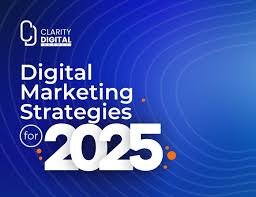Digital Marketing Strategies That Actually Work in 2025
Introduction
As the digital marketing landscape continues to evolve in 2025, businesses must adapt to new trends and technologies to stay competitive. What worked in previous years may no longer be effective, making it crucial to implement fresh, innovative strategies. In this article, we’ll explore the most effective digital marketing strategies of 2025, providing actionable insights to help your business drive real results, increase engagement, and boost conversions.
1. AI-Powered Personalization
Artificial intelligence (AI) has revolutionized digital marketing, and its role in personalization is more critical than ever. In 2025, consumers expect a tailored experience, from product recommendations to personalized email campaigns. AI enables businesses to deliver content that resonates with each user, enhancing customer satisfaction and increasing the chances of conversion.
Why It Works:
-
Enhanced User Experience: Personalization based on user behavior, preferences, and demographics results in a more engaging experience.
-
Higher Conversion Rates: Personalized content leads to higher engagement and increased conversions, as consumers are more likely to purchase when content feels relevant to them.
-
Efficient Data Use: AI analyzes vast amounts of data to understand customer behavior and predict future actions, allowing for highly targeted marketing strategies.
How to Implement It:
-
Use AI-powered tools like ChatGPT for customer interactions or email automation.
-
Leverage platforms like Google Ads and Facebook to create dynamic, personalized ads based on user actions.
Impact: Personalized marketing increases customer loyalty and sales, making it a must-have strategy for 2025.
2. Video Marketing Dominates
Video content continues to be one of the most effective ways to capture attention in 2025. With the rise of short-form videos, live streaming, and interactive video content, businesses must incorporate video into their marketing strategy to stay relevant. Platforms like YouTube, TikTok, Instagram Reels, and even LinkedIn are all excellent avenues for video marketing.
Why It Works:
-
Higher Engagement: Videos capture attention faster than text or images, leading to increased engagement rates.
-
Shareability: Video content is highly shareable, increasing the likelihood of viral marketing.
-
SEO Benefits: Video content boosts your SEO rankings, as search engines prioritize engaging media that increases time spent on a page.
How to Implement It:
-
Invest in high-quality video production for product demos, tutorials, and behind-the-scenes content.
-
Use live streaming to interact with your audience in real time, answering questions or providing exclusive content.
Impact: Video marketing significantly increases brand awareness, customer engagement, and conversion rates.
3. Voice Search Optimization
With the rise of voice-activated devices like smart speakers and voice assistants on smartphones, voice search is a growing trend in 2025. Consumers are using voice search to find local businesses, products, and services quickly, making it essential for marketers to optimize their content for voice queries.
Why It Works:
-
Mobile and On-the-Go: Voice search allows users to search for information while multitasking or on the move, making it a highly convenient tool.
-
Long-Tail Keywords: Voice searches tend to be longer and more conversational, which opens opportunities for targeting long-tail keywords that may be overlooked in traditional SEO strategies.
-
Local SEO: Voice searches often focus on local queries (e.g., “Where is the nearest coffee shop?”), making local businesses more discoverable.
How to Implement It:
-
Focus on natural, conversational language in your content and optimize for long-tail keywords.
-
Ensure your website is mobile-friendly and optimized for local search terms.
Impact: Optimizing for voice search improves your visibility and makes it easier for customers to find your business using voice-enabled devices.
4. Interactive and Immersive Content
Interactive content, such as quizzes, polls, and interactive infographics, has become a significant trend in 2025. Augmented reality (AR) and virtual reality (VR) are also playing a larger role, offering immersive experiences that engage users on a deeper level.
Why It Works:
-
Engagement: Interactive content encourages users to participate, which increases time on site and interaction with your brand.
-
Personalized Experiences: With AR and VR, users can have unique, personalized experiences, such as trying out products virtually before purchasing.
-
Shareability: Interactive and immersive content is more likely to be shared, which helps extend your brand’s reach.
How to Implement It:
-
Create quizzes or polls related to your product or services to engage your audience.
-
Experiment with AR or VR for product demonstrations or immersive brand experiences.
Impact: Interactive and immersive content boosts engagement, brand recall, and social shares, driving traffic and creating stronger customer connections.
5. Influencer Marketing and Micro-Influencers
Influencer marketing continues to grow in 2025, with brands turning to micro-influencers to reach more targeted, engaged audiences. Micro-influencers typically have smaller but highly loyal followings, making them a cost-effective option for businesses looking to drive authentic engagement.
Why It Works:
-
Authenticity: Micro-influencers tend to have more personal connections with their followers, leading to higher trust and engagement.
-
Targeted Reach: Micro-influencers often cater to niche audiences, allowing brands to connect with specific demographic groups.
-
Cost-Effective: Compared to larger influencers, micro-influencers are typically more affordable while still providing high ROI.
How to Implement It:
-
Research influencers within your niche who have high engagement rates and align with your brand values.
-
Offer products or incentives in exchange for authentic, organic reviews and mentions.
Impact: Micro-influencer campaigns lead to higher engagement and more authentic connections with customers, providing strong ROI on marketing spend.
6. Social Commerce and Shoppable Posts
Social commerce continues to evolve in 2025, with platforms like Instagram, Facebook, and TikTok allowing businesses to sell directly through social media. Shoppable posts are becoming more integrated into the user experience, enabling customers to discover, research, and purchase products without leaving the platform.
Why It Works:
-
Seamless Shopping: Social commerce reduces friction by allowing users to shop directly from their social media feeds, creating a smooth path from discovery to purchase.
-
Impulse Buying: The convenience of shoppable posts increases the likelihood of impulse purchases.
-
Global Reach: Social media platforms have global audiences, enabling businesses to reach customers worldwide.
How to Implement It:
-
Set up a shop on platforms like Instagram or Facebook to sell directly to your audience.
-
Create engaging posts with clear product links and calls to action, encouraging easy purchases.
Impact: Social commerce allows you to leverage your social media presence to generate sales directly, boosting conversions and revenue.
7. Sustainability and Ethical Marketing
In 2025, consumers are increasingly prioritizing sustainability and ethical considerations when making purchasing decisions. Brands that emphasize sustainability and align their values with eco-conscious practices are gaining trust and loyalty among socially responsible consumers.
Why It Works:
-
Consumer Demand: Consumers are becoming more aware of the environmental impact of their purchases, and they prefer brands that align with their values.
-
Brand Loyalty: Ethical marketing builds deeper connections with customers, encouraging brand loyalty and repeat purchases.
-
Competitive Advantage: Sustainability is a key differentiator in a crowded market, making it easier to stand out.
How to Implement It:
-
Highlight your eco-friendly practices and products in your marketing campaigns.
-
Share your sustainability efforts transparently, including any certifications or initiatives you’re involved in.
Impact: Ethical marketing enhances brand image, attracts environmentally conscious consumers, and differentiates your business in a competitive market.
Conclusion
In 2025, digital marketing is evolving rapidly, and staying ahead of the curve requires embracing the latest strategies. From AI-powered personalization and interactive content to influencer marketing and social commerce, businesses need to adapt to these trends to remain competitive. By implementing these proven digital marketing strategies, you can drive real traffic, foster engagement, and build a sustainable online presence that thrives in the ever-changing digital landscape.











